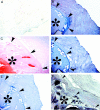Matrix metalloproteinase-2 is associated with tenascin-C in calcific aortic stenosis
- PMID: 11438479
- PMCID: PMC1850407
- DOI: 10.1016/S0002-9440(10)61698-7
Matrix metalloproteinase-2 is associated with tenascin-C in calcific aortic stenosis
Abstract
We previously showed that the expression of tenascin (TN-C), an extracellular matrix glycoprotein found in developing bone and atherosclerotic plaque, and matrix metalloproteinase-2 (MMP-2) are coordinated and interdependent in cultured vascular smooth muscle cells. In this study, we hypothesized that TN-C and MMP-2 are mechanistically involved in the pathobiology of calcific aortic stenosis. Human calcific aortic stenosis cusps demonstrated immunohistochemically prominent deposition of TN-C, MMP-2, and alkaline phosphatase activity, as well as MMP-2 gelatinolytic activity. Although far lesser amounts of TN-C were noted in several of the grossly non-calcified valve cusps, MMP-2 and AP were never detected. Further, when aortic valve interstitial cells (both sheep and human) were cultivated on collagen supplemented with TN-C, both MMP-2 mRNA expression and MMP-2 gelatinolytic activity (both pro and active forms), were up-regulated compared to control. These observations support the view that accumulation of first TN-C and then MMP-2 are associated with progression of calcification. The residual presence of these proteins in severe calcifications is indicative of their involvement in the pathogenesis.
Figures



References
-
- Kim KM: Calcification of matrix vesicles in human aortic valve and aortic media. Fed Proc 1976, 35:156-162 - PubMed
-
- Kim KM: Apoptosis and calcification. Scanning Microsc 1995, 9:1137-1178 - PubMed
-
- Srivatsa SS, Harrity PJ, Maercklein PB, Kleppe L, Veinot J, Edwards WD, Johnson CM, Fitzpatrick LA: Increased cellular expression of matrix proteins that regulate mineralization is associated with calcification of native human and porcine xenograft bioprosthetic heart valves. J Clin Invest 1997, 99:996-1009 - PMC - PubMed
-
- Bini A, Mann KG, Kudryk BJ, Schoen FJ: Noncollagenous bone matrix proteins, calcification, and thrombosis in carotid artery atherosclerosis. Arterioscler Thromb Vasc Biol 1999, 19:1852-1861 - PubMed
-
- Mori K, Shioi A, Jono S, Nishizawa Y, Morii H: Expression of matrix Gla protein (MGP) in an in vitro model of vascular calcification. FEBS Lett 1998, 433:19-22 - PubMed
Publication types
MeSH terms
Substances
Grants and funding
LinkOut - more resources
Full Text Sources
Miscellaneous

